100 Greatest Bassists of All Time
- Oops!Something went wrong.Please try again later.
- Oops!Something went wrong.Please try again later.
- Oops!Something went wrong.Please try again later.
- Oops!Something went wrong.Please try again later.
- Oops!Something went wrong.Please try again later.
The post 100 Greatest Bassists of All Time appeared first on Consequence.
Consequence’s Bass Week kicks off with a list of 100 Greatest Bassists of All Time. Keep checking back throughout the week for lists, artist-driven content, and more.
“None of us wanted to be the bass player. In our minds he was the fat guy who always played at the back.” –– Paul McCartney
While Macca’s quote may be a bit harsh, it is true that bassists primarily stay out of the spotlight. However, they can often be the driving force in the band, whether keeping rhythm with the drummer or delivering a groovy line all their own. Or, as in the case of McCartney, they can be among the most beloved musicians ever.
When Consequence set out to determine the greatest bassists of all time, we didn’t want to just go on skill alone — otherwise the list below would look a lot different. Sure, technical ability plays a big part, but influence, songwriting, innovation, stage presence, and more were all factors.
Not to mention, we got a lot of help. We surveyed more than 30 bass players from various bands across genres. Each one of them gave us their own personal Top Five, and we factored in their selections with our own staff picks. We also asked them to tell us why their choices deserved recognition, and included those testimonials in final list.
What resulted is a list that features the old-school jazz and Motown players who set the foundation for the rock bassists to follow, alongside notable musicians from classic rock, punk, heavy metal, pop, R&B, new wave, disco, and more. Wherever they made their name, each one of these artists has left a deep (literally) mark on music.
So, take a ride along the low-end as we count down the 100 Greatest Bassists of All Time. We’ll be keeping the rhythm rolling all week with contributions from more artists throughout Bass Week, so check out all the content here.
-Spencer Kaufman
Managing Editor, Heavy Consequence
100. Troy Sanders
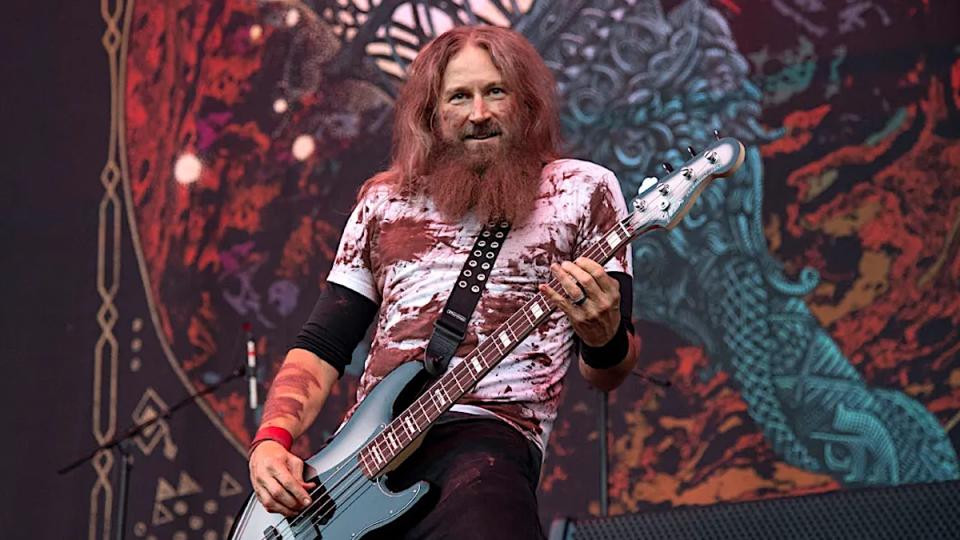
Troy Sanders, photo by Amy Harris
As singer-bassist in Mastodon, Troy Sanders helped pioneer the sludge metal sound heard on Mastodon’s seminal early albums. And while there’s a sharp contrast between Mastodon and Motörhead, the crushed-out, distorted low-end of the latter band’s legendary Lemmy Kilmister paved the way for bassists like Sanders. What sets Sanders apart from his peers is his post-hardcore background, as he brings a prog-like technicality that melds brutal tones and with rhythmic complexity — arguably Mastodon’s defining trait. — Jon Hadusek
99. Jenny Lee Lindberg
If you’ve ever had the thrill of seeing Warpaint play, you’ve undoubtedly noticed the way Jenny Lee moves on stage, how her whole body is expressed in her playing. The basslines she writes and plays are an extension of that physicality: These are basslines you simply cannot sit and play, you have to get up and move with them. Lindberg’s basslines slide, they bounce, they sneak, they push and pull, like a force with teeth, alive and hungry. The effect is hypnotic in the best way. — Nick Harmer (Death Cab for Cutie)
98. Leland Sklar
Leland Sklar has lived many session player’s dream, first as a member of James Taylor’s backing band, and then becoming a staple at Asylum Records as part of the label’s house band, The Session. In addition to Taylor, Sklar has recorded with heavy hitters like Carole King, Phil Collins, and Linda Rondstadt, among many others. His setup is famously simple, which helps make him one of the more agile bassists. — Mary Siroky
97. Tom Petersson
Not only can Tom Petersson’s bass playing be heard on Cheap Trick’s classic songs, the dude helped conceive and develop the 12-string bass that he has famously played for roughly a half century. — S. Kaufman
Tom Petersson’s 8- and 12-string basses are just amazing. Half the time, you don’t even realize that it’s only one instrument. It sounds like rhythm guitar and bass at the same time, but I just love that sound. — Trevor Dunn (Mr. Bungle)
96. George Porter Jr.
Funk music wouldn’t have been the same without George Porter Jr. The New Orleans instrumentalist and co-founder of The Meters has been part of The Big Easy’s music scene for six decades, from prodigy to elder statesmen. He collaborated in-studio with David Byrne and Tori Amos, and his band The Runnin’ Pardners is still running today. — M. Siroky
95. Melissa Auf Der Mar
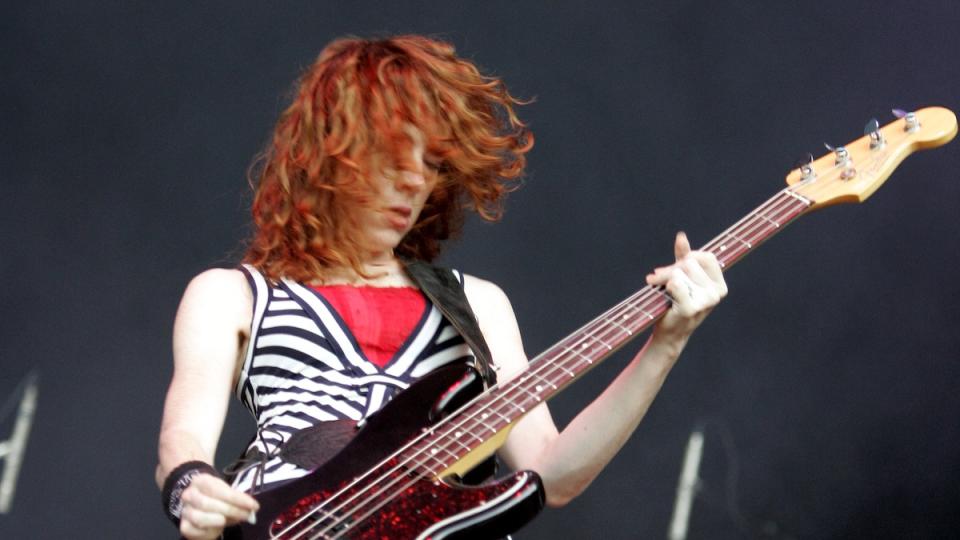
Melissa Auf der Maur, photo by Jean Baptiste Lacroix/WireImage
Melissa Auf der Maur initially made a name for herself in the Montreal music scene by fronting the band Tinker before her pen pal, Billy Corgan, got her an audition to be Hole’s new bassist. Even though she declined Courtney Love’s offer at first, Auf der Maur was with the band for about five years (performing on the landmark Celebrity Skin), before briefly linking with The Smashing Pumpkins in 1999. Add in a fascinating solo career, and her bass is an essential sound of turn-of-the-millenium alternative rock. — Sun Noor
94. Nick Harmer
[Death Cab for Cutie’s] Nick [Harmer] just bops! He comes off as so assured and it makes for these amazing, winding basslines like on “Summer Skin” or “I Will Possess Your Heart.” He also always seems to find the perfect transitional note when he’s walking up to the next part of a measure (“Soul Meets Body,” “Grapevine Fires”), and I think when those little notes flash by, they carefully turn the screws on everything around them and lock a song in. — Sean Neumann (Ratboys)
93. Nik West
In terms of pure pizazz, few bassists can match Nik West. Her Millennial reinterpretations of funk drew the attention of Prince, Eurythmics’ Dave Stewart, John Mayer, and others, but it’s her sizzling stage presence that makes her unforgettable. All bright colors and funky slapping technique, she puts the idea of the boring bass player to rest with her electric solo work. –– Venus Rittenberg
92. Alex Webster
Good luck playing death metal without goopy, cavernous, and utterly thick bass tones. As the founding bassist for Cannibal Corpse — the GOAT of OSDM — bassist and founding member Alex Webster discovered as much in the late ’80s, when extreme metal finally embraced subsonic frequencies and birthed death metal as we know it. The down-tuned gurgling underbelly of Cannibal Corpse and the genre at large remains indebted to Webster, one of its earliest practitioners. –– J. Hadusek
91. Krist Novoselic
Krist Novoselic sometimes gets knocked for ‘merely’ writing simple, hummable basslines, as if a riff that gets stuck in your head is something anyone can do. His fuzzed-out bass tone inspired a generation of players, and Nirvana’s loud-soft dynamics worked so well because the rhythm section was so tight. Other artists on this list spent more time showing off, but Novoselic’s work won’t be forgotten any time soon. — Wren Graves
90. Doug Pinnick
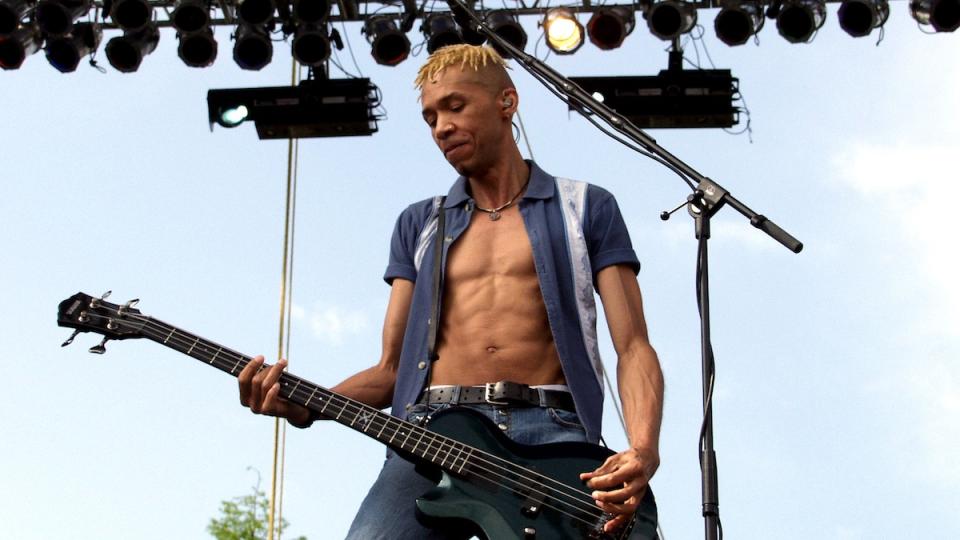
Doug Pinnick, photo by Chris McKay/WireImage
Like Tom Petersson of Cheap Trick, King’s X singer-bassist Doug Pinnick is known for his mastery of the 12-string bass, and his combination of groove and distortion has powered the progressive metal band for more than 40 years. His resume reaches far beyond King’s X, as he’s also released a number of solo albums and has played in supergroups like KXM and Pinnick, Gales & Pridgen, among other projects. — S. Kaufman
89. Mike Dirnt
The Green Day bassist brings bouncy basslines, thick, meaty tones, and heaps of style to his band. Mike Dirnt has created so many indelible riffs that range from complex to the powerfully simple — “Longview,” “When I Come Around,” “She,” and “Minority” come to mind, but his impact on every Green Day album cannot be understated. No matter the tune, Dirnt’s undeniable skill is palpable in the mix . — Paolo Ragusa
88. Steve DiGiorgo
Extreme metal journeyman Steve DiGiorgio has an extensive list of bass credits, though his work on the Death albums Human and Individual Thought Patterns are perhaps his crowning achievements. DiGiorgio was one of the first to embrace a fretless bass in the field of death metal (Death’s “Vacant Planets” is a strong example), and his heavily prog-influenced playing has become the de facto bass style for the technical death metal genre. His other credits include albums by Sadus (which he co-founded), Autopsy, Testament, and Iced Earth, not to mention that he’s the current bassist for Megadeth. — J. Hadusek
87. Suzi Quatro
Legendary rocker Suzi Quatro made a name for herself bouncing around the Detroit scene in the ’60s in an all-female band, The Pleasure Seekers, before she broke out as a soloist in her own right in the early ’70s. Quatro infused her Motown roots and love for soul music in every step of her career, developing an affinity for basslines that sat in contrast to a melody. Her mastery of the instrument proved to be more than enough to command the spotlight. — M. Siroky
86. Yves Tumor
Yves Tumor is fluent in so many different genres and instruments, but in their music, the bass ties it all together. From the early genre-bending experimentations through their recent rock god ascension, Tumor has showed a nearly unparalleled ability to create a pocket for the rest of the song to slide into. The backbone of “Noid,” the whole second half of Heaven to a Tortured Mind, and every song on Praise a Lord… (our favorite album of 2023) is a four-string masterclass. Even the bass samples, like the one on “Echolalia” from NEON’s “Lobotomy,” are pure bass nerdery. — W. Graves
85. Phil Lynott
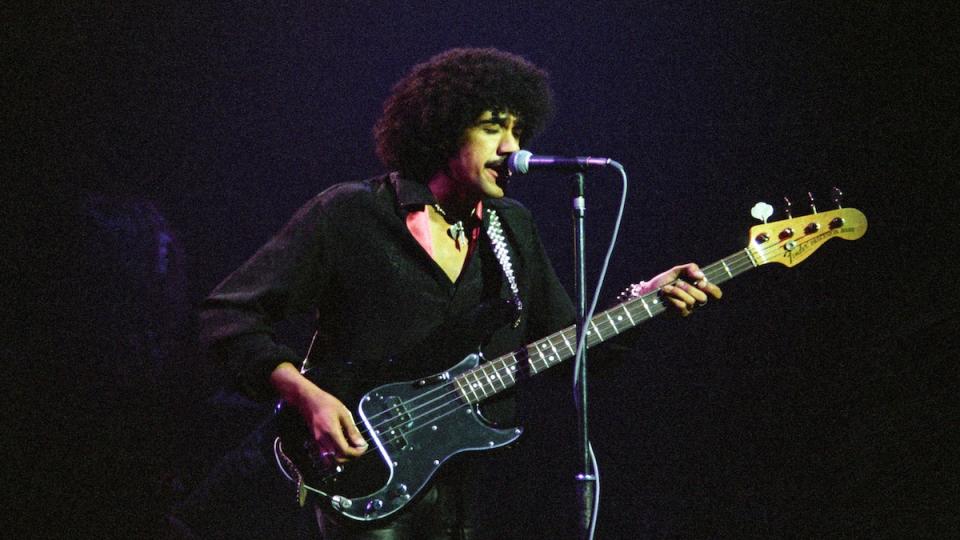
Phil Lynott, photo by Pete Still/Redferns
When the frontman of a band is holding a bass, you know shit’s about to get good — and that’s largely thanks to the precedent set by hard rockin’ icons like Thin Lizzy’s Phil Lynott. Pick in hand, his voice and basslines were able to keep up with his band’s symphony of guitar theatrics, ultimately helping iron out the blueprint for the four-stringed instrument’s role in hard rock and heavy metal. — Jonah Krueger
Incredible rock riffs. Have they put up a statue of any other bassist? [Editors note: Yes, but point still taken.] — Nestor Chumak (PUP)
84. Martin Mendez
As the music of Opeth grew more and more progressive throughout the 1990s, it demanded tighter instrumental prowess from the musicians. Enter Martin Mendez, who took over in 1997 ahead of the band’s classic three-album run beginning with 1998’s My Arms, Your Hearse. Mendez’s worldclass skills translate to all of Opeth’s sonic facets, from death metal to straight clean-toned prog, and he plays his role well, receding into the rhythmic backdrop when necessary and stepping up for the odd bass riff or solo when the song calls for it. — J. Hadusek
83. Scott LaFaro
The Bill Evans Trio records with Scott LaFaro are really free. Scott LaFaro was a huge influence on me, but maybe not the best early influence for a bass player because he was so advanced and free. If I’m teaching someone how to play jazz, I would start more basic, but I really got into him early and started playing jazz that way. –– Trevor Dunn (Mr. Bungle)
82. David Ellefson
Despite where the tumultuous relationship between David Ellefson and Dave Mustaine currently stands, nobody can discredit Ellefson’s contributions to Megadeth’s musical legacy. He provided the thumping low-end on the band’s most celebrated albums throughout the ’80s and ’90s, and he even has an iconic bassline to his name in the form of the “Peace Sells” intro, notably used as the MTV News outro theme. — J. Hadusek
81. Phil Lesh
As a founding member of the Grateful Dead, Phil Lesh takes a distinctly melodic approach to the instrument. But more than just crafting adventurous basslines, Lesh also rarely sticks to what he might have laid down in a recording, giving himself the space to experiment on the fly and making one performance of a song different from how he might play it the very next night. This “stream of consciousness” style is a testament to Lesh’s creativity. — M. Siroky
80. Justin Chancellor

Justin Chancellor, photo by Amy Harris
With all respect to Paul D’Amour’s picking on Opiate and Undertow, Chancellor is the reason Tool leveled up on Ænima. Starting from the “Stinkfist” riff and his playful bridge, it’s clear that Chancellor is doing much more than try to keep up. “Schism” is perfect in its simplicity, the lovely harmonics of “Dispositions” are a technical wonder, and if you can track the rhythm, “Rosetta Stoned” is about as much fun as a person can legally have on four strings. He made a good band great. — W. Graves
79. Laura Lee Ochoa
In Khruangbin, Laura Lee Ochoa’s warm, indulgent basslines are a definite highlight. She’s a master of tone, bringing gorgeous compliments to Mark Speer’s gentle guitar work and DJ Johnson’s carefully-drawn drum lines, creating a rhythmic tapestry that ties the trio together. Ochoa’s myriad of global influences establish her sonic variety and her versatile feel on the instrument, allowing each Khruangbin song to contain basslines designed to live in forever. — P. Ragusa
78. Roger Glover
Deep Purple might be most famous for a guitar riff — yes, that guitar riff — but beneath the smoke resting on the water lies killer bassline after killer bassline, all courtesy of Roger Glover. The bassist grounded the group, giving rockers like “Highway Star” or “Space Truckin’” the cojones they deserved. For that, as well as his contributions to Ritchie Blackmore’s Rainbow, Glover rightfully stands as one of hard rock’s premier bassists. — J. Krueger
77. Brian Ritchie
Brian Ritchie lies at the heart of Violent Femmes folk punk angst. Sure, the snarling vocals and blistering (ha!) acoustic guitar help round out the band’s folky fury, but Ritchie’s bass holds it all together, acting as an anchor for the eccentricities of the rest of the band while managing to match their energy. It’s a delicate balance, but one that Ritchie perfected almost immediately with his iconic acoustic bass. — J. Krueger
76. Doug Wimbish
Doug Wimbish might be best known as the bassist for the hard rock act Living Colour, but his contributions to the low-end of music extend far beyond barn-burners like “Cult of Personality.” Beyond laying down sick-ass basslines for the funk-mental act, Wimbish has worked with artists in just about every genre, from Sugarhill Gang to James Brown, Grandmaster Flash to Depeche Mode. He was even a permanent member of the house rhythm section of Sugarhill Records. Talk about leaving your mark. — J. Krueger
75. Paz Lenchantin
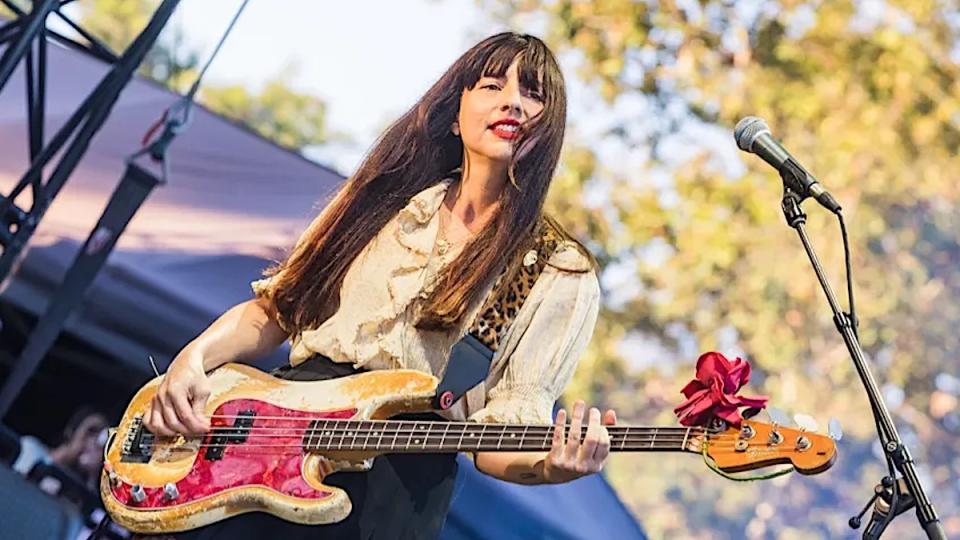
Paz Lenchantin, photo by Debi Del Grande
A Perfect Circle and The Pixies are nothing alike musically, thus proving Paz Lenchantin’s versatility as a bass player. Not only did she fit in beautifully in both acts, but she was also a shining light in Billy Corgan’s short-lived band Zwan. Along with holding down the low-end, she’s also a wonderful vocalist and a skilled violinist. — S. Kaufman
74. Michael Anthony
First off, imagine how difficult it must have been to create the stand-out basslines alongside the mighty Eddie Van Halen! Before most of us ever even heard Eddie play, we first heard Michael Anthony’s bassline on the Van Halen debut needle drop, with his eight driving distorted quarter notes on the intro of “Running with the Devil,” which would define his legacy as the foundation to the mighty Van Halen forever. Michael’s tone and freeform ad lib parts (especially on Women & Children First) were the underpinnings of Eddie’s musical odyssey. — David Ellefson (Dieth, Kings of Trash)
73. Joe Lally
Joe Lally etched his name into punk rock history with perhaps the defining bassline of post-hardcore: “Waiting Room.” As Fugazi (and Messthetics) fans know, however, Lally’s energetic contributions to the world of rock bass don’t stop there. His work often becomes the focal point of the composition, ultimately serving as a shining example of just how bullshit the notion of “If a bassist is doing their job perfectly, you won’t notice it” really is. — J. Krueger
72. John Deacon
John Deacon is one of few instrumentalists who could steal the spotlight from Freddie Mercury, as he did on Queen’s “Another One Bites the Dust,” as well as David Bowie, which he did with four notes and a fourth down (co-written by Bowie) on “Under Pressure.” If he had wanted, he probably could have had a brilliant solo career, but that wasn’t his style. Listen to the more restrained supporting bass parts on other Deacon songs like “I Want to Break Free,” and you’ll hear a selfless artist committed to doing whatever it takes. — W. Graves
71. David Hood
When Mavis Staples coos, “I need you here. Help me out,” to “Little David” on “I’ll Take You There,” she’s talking to David Hood. A member of the Muscle Shoals Rhythm Section, Hood helped lay the foundation for the group’s legendary output. But he’s also heard across pop (Paul Simon’s “Kodachrome”), rock (Bob Seger’s “Old Time Rock and Roll”), and Americana (with his son, Drive-By Truckers’ Patterson). Although not a flashy player, Hood can nestle supple grooves into whatever pocket surrounds him. — Ben Kaye
70. Eric Avery
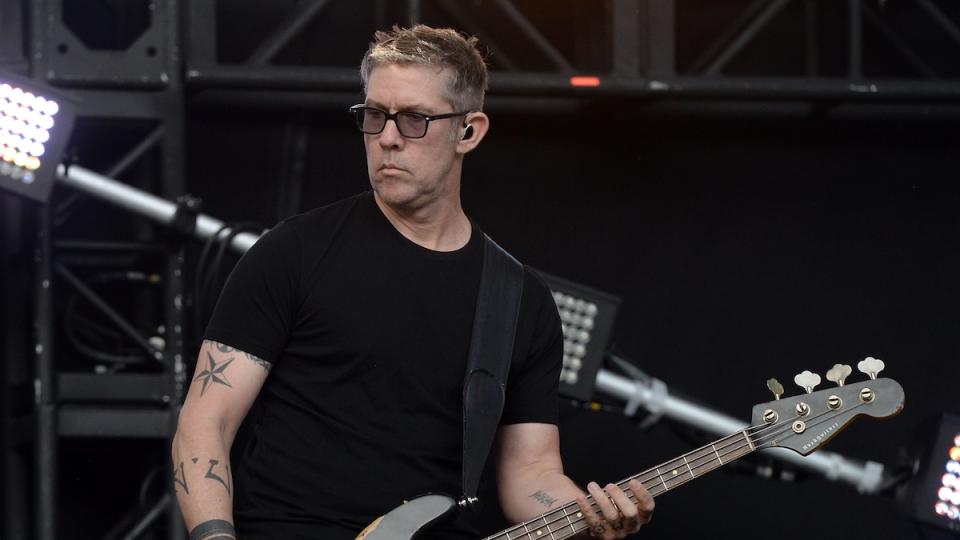
Eric Avery, photo by Scott Dudelson/WireImage
A key component that set Jane’s Addiction most apart was the bass playing of Eric Avery. Sure, Farrell had pipes and Navarro could shred, but Avery’s musical touch brought those two away from Sunset Strip and into the skate park. For all the celebrity of his bandmates, Eric Avery is the quiet hero and his contributions to Nothing’s Shocking hold up as some of the best rock bass playing, period. Melodic, full of hooks, indelible tone, exceptional feel, but I digress. I fell in love with the bass guitar learning how to play Eric’s parts on this album. Through him I began to understand how the bass could support and stand out without stealing the spotlight and being overly flashy. — Nick Harmer (Death Cab for Cutie)
69. Rick Danko
The fingerprints of Rick Danko’s bass playing and songwriting are littered throughout rock music’s canon. A founding member of The Band, Danko’s excellence doesn’t come from flashiness or virtuosity, but rather his undeniable intuition, always perfectly supplementing the jam at hand. Throw on “The Weight” and listen for Danko — you might not have noticed it during casual listening sessions, but he’s keeping the whole damn thing together. — J. Krueger
68. Esperanza Spalding
Esperanza Spalding made global headlines back in 2011 for winning the Best New Artist Grammy over Justin Bieber, introducing many to the next jazz superstar. The virtuosic bass player creates abstract compositions with a unique blend of bossa nova, soul, and R&B, performed with utter precision and soul. Eight albums in, Spalding continues to prove that she’s not just another gifted jazz artist, but an undeniable musical genius. — S. Noor
67. Pino Palladino
One of the greatest electric bass players ever. His pocket is undeniable and you can hear him on everything from early Peter Gabriel records to Dangelo to modern pop records. He is a chameleon while at the same time having a sound so distinctive. Probably one of the biggest influences in getting bass players in recent years to sit far behind the beat. He is a bass player’s bass player, while at the same time always serving the song so perfectly. –– Dan Molad (Coco/Lucius)
66. Paul Jackson
Paul Jackson made his mark as a member of Herbie Hancock’s band Headhunters and as a player on Hancock’s solo albums. In the mid ’80s, he moved to Japan, where he established Jazz for Kids, teaching Japanese youth about African-American history via music until his passing in 2021. –– S. Kaufman
There’s so many great records with Paul Jackson, but all those Herbie Hancock records that he’s on, I love. There’s just kind of a freedom, very funky, but very free at the same time. He is probably one of my bigger influences. — Trevor Dunn (Mr. Bungle)
65. Gail Ann Dorsey
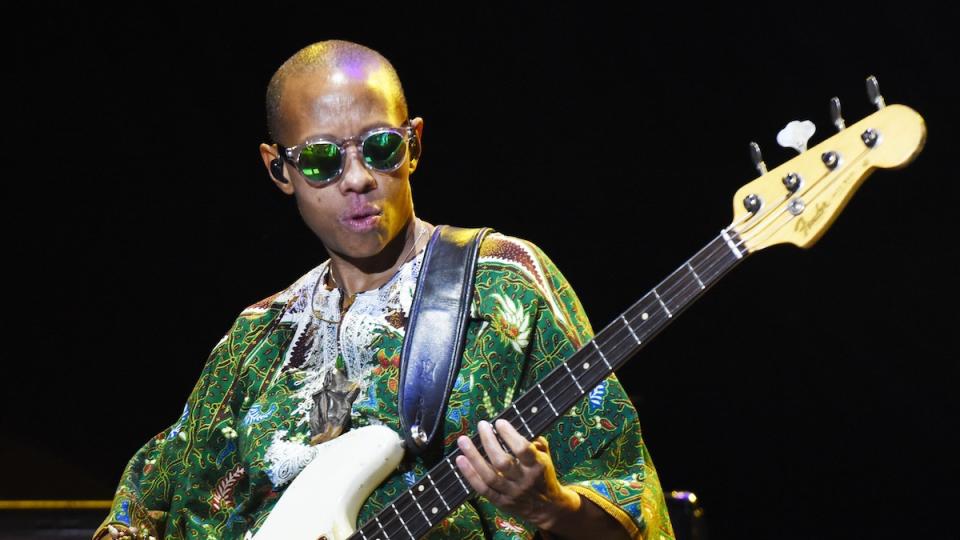
Gail Ann Dorsey, photo by Chris McKay/Getty Images for Live Nation
Although she’d collaborated with acts like Tears for Fears and Gang of Four, Gail Ann Doresy is mostly known for her work with David Bowie. She was a fixture of Bowie’s live band from 1995 through his live retirement in 2004, even taking Freddie Mercury’s vocal parts while laying down one of music’s sickest basslines during “Under Pressure.” Her resumé also includes Lenny Kravitz, The B-52’s, and The Indigo Girls, on top of numerous vocal collaborations (The National, The Charlie Watts Big Band). And to think, the Philadelphia-born musician initially sought out to become a guitarist. — S. Noor
64. Noel Redding
It might not have been called the Noel Redding Experience, but the bass player was nonetheless essential when it came to turning Jimi Hendrix into the Jimi Hendrix Experience. Playing alongside arguably the greatest guitar player to ever do it, Redding held his own, getting flashy when the song called for it and knowing when to step aside for Hendrix’s theatrics. He was an all-time support player who deserves all the respect in the world. — J. Krueger
63. Paul Chambers
Jazz great Paul Chambers walked all over the fretless fingerboard of a double bass, and he’s heard on many a standard. That’s him all over Miles Davis’ Kind of Blue, and keeping John Coltrane on his toes throughout Giant Steps. Chambers, who passed away at just 33, knew how to fit between the spaces of a combo like no other, while also leading them into uncharted territory with his knack for navigating melody and harmony. — B. Kaye
62. Tal Wilkenfeld
Very few bassists have a resume as stacked as Tal Wilkenfield. Her tenacity — and more importantly, talent — has led her to share stages with Jeff Beck, Incubus, Eric Clapton, Prince, and Mick Jagger, and she’s recorded with the likes of Ringo Starr and Brian Wilson. But if all those stamps of approval aren’t enough, take a listen for yourself, and you’ll hear a skilled instrumentalist who has developed into a songwriter and bandleader very much in her own right. — M. Siroky
61. Sting
Sting is a charismatic, impressive frontman, but let us not forget his remarkable abilities on the bass guitar. It’s evident in The Police’s biggest songs, with Sting working perfectly off of Stewart Copeland’s backbeat emphasis and adding body to Andy Summers’ kaleidoscopic guitar lines. As the group’s primary songwriter, Sting very carefully let his bass work shine in a myriad of ways, lending memorable moments to “Every Little Thing She Does is Magic” and the expansive, otherworldy Zenyatta Mondatta. — P. Ragusa
60. Matt Freeman
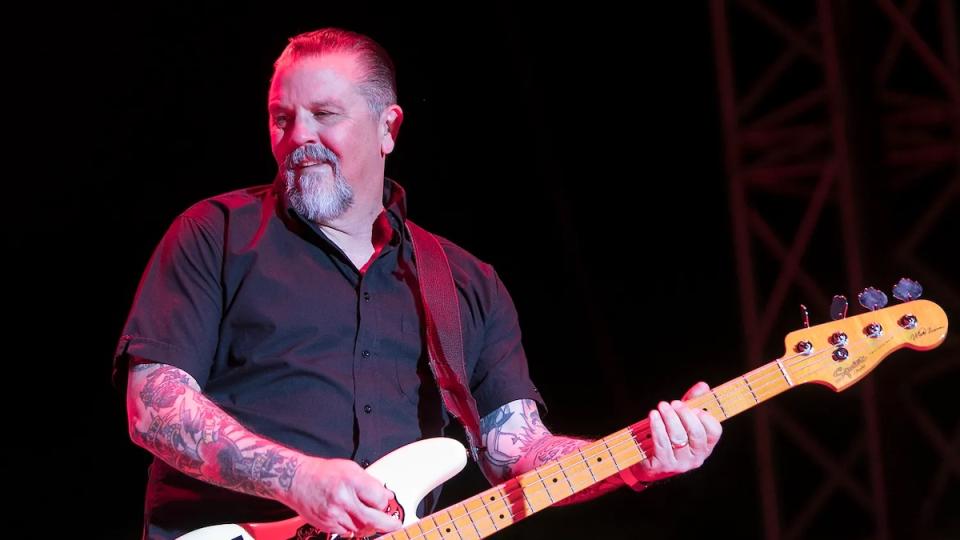
Matt Freeman, photo by Raymond Ahner
When you think of early punk music, you hear the bass, but you don’t necessarily think of or pay too much attention to the bass — but when Matt Freeman came along in the late ’80s with Operation Ivy, he changed that forever. And even more so when he and Tim Armstrong formed Rancid. Matt is a busy bass player, no doubt about that, but not just busy to be busy. Every Rancid song has a bass hook and yet it doesn’t seem like it takes away from the vocals ever. It complements the vocal and it happens in every song. Operation Ivy and Rancid don’t have their signature sound without Matt Freeman. Period. — Cone McCaslin (Sum 41)
59. Chuck Rainey
One of the most recorded bassist of all time, Chuck Rainey may also be one of the most heard bassists ever; millions of people heard his bass welcome on Sanford & Son nearly every Friday from 1971 to 1977. His work with Quincy Jones was part of a prolific ’70s, which included landmark recordings with Aretha Franklin (“Rock Steady”) and Allen Toussaint (“Just a Kiss Away”). Rainey’s insane range is best displayed on the isolated track for Steely Dan’s “Kid Charlemagne,” a song on which he once said he “played everything I knew.” — B. Kaye
58. Robbie Shakespeare
Robbie Shakespeare — one half of the production duo Sly & Robbie, known for their work with Grace Jones, Joe Cocker, Bob Dylan, and No Doubt — was an understated genius on the bass guitar. His work with artists as a session musician was just as influential as when he and Sly were behind the boards calling the shots, and you can hear his laidback, masterful grooves on four decades of music. He’s called “Basspeare” for a reason — his work on the instrument is almost as prolific as his namesake. — P. Ragusa
57. Rex Brown
Rex Brown is the unsung hero of Pantera — the steady, sobering hand that has guided the group since its inception. With the musical virtuosity of Dimebag Darrell and Vinnie Paul being more “up front” and palpable, Brown — like many bassists — naturally slid into the background. But it was his propulsive airtight bass playing that acted as the glue in the mix, allowing the late brothers to freewheel and flex on their instruments. –– J. Hadusek
56. Tony Levin
Innovation defines Tony Levin’s style on the bass. The King Crimson bassist is credited with developing funk fingers alongside his guitar tech, Andy Moore — because not everyone would be brave enough to see what happens when you attach two short drumsticks to your hand and keep playing. Beyond that, Levin also certainly helped popularize the Chapman Stick, a distinct and recognizable instrument; essentially, Levin is the perfect argument against the idea that a good bass player is meant to blend in and go unnoticed. — M. Siroky
55. Meshell Ndegeocello
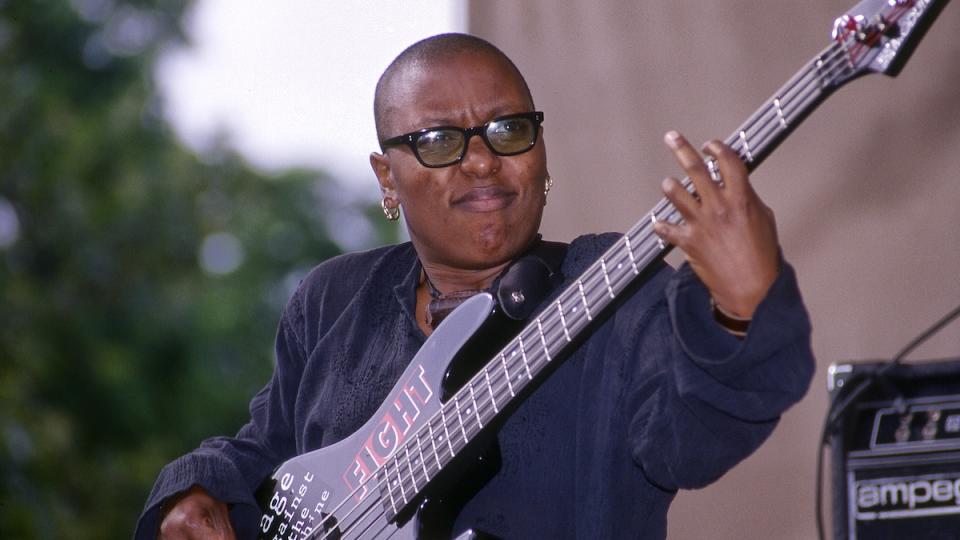
Meshell Ndegeocello, photo by Bill Tompkins/Getty Images
When Meshell [Ndegeocello] plays live, she sings and plays — so when you listen to her records and imagine her singing and playing these songs on bass, it’s insane. She’s a big inspiration to me, being a singer and a bass player myself — doing that at the same time and figuring out where the vocal fits within the bassline. She’s a master of that. Her groove, her slap bass, and her feel on the instrument is so special. — Blu DeTiger
54. Charlie Haden
As an original member of the Ornette Coleman Quartet, Charlie Haden helped invent free jazz, transforming the double bass from accompaniment to key improviser, while switching chords and moods as fast as Coleman could think. He would go on to play with Keith Jarrett and become Jack Black’s father-in-law, in addition to a never-dull solo career. Haden demonstrated that there was melody to be made in the low-end, and not just groove. — V. Rittenberg
53. Trevor Dunn
When it comes to the intersection of metal, jazz, and avant-garde, there’s few who do it better than Trevor Dunn. Coming up with Mr. Bungle, Dunn’s known for getting weird with it, and yet, he’s also an incredibly proficient double bass player and an accomplished composer. In addition to Bungle, Fantômas, Tomahawk, Melvins, and his own albums, Dunn has appeared on a number of John Zorn releases, proving his playing has no boundaries. — J. Krueger
52. Bob Moore
In the late ’50s, a crack session unit was set up with a commitment to changing the scene. Wanted by every Nashville Sound performer from Patsy Cline to Elvis, these backing artists thrived as session musicians of fortune. If an artist needed a session band, if no one else could help — and if they could find them — they would hire the Nashville A-Team. At the group’s rhythmic center stood Bob Moore with his upright, and his performances permeate almost all of country music from that era and region. — B. Kaye
51. Robert Trujillo
Robert Trujillo will forever be most known as the late-era bassist of Metallica, but his resume is extensive. Trujillo cut his teeth in the West Coast metal scene as a member of Suicidal Tendencies and Infectious Grooves in the 1990s, perfecting a funky style of heavy metal bass playing that also boasted a visual element (it’s hard to hear Trujillo’s bass and not picture his signature legs akimbo stomp-walk stage moves). When it came time for the veteran bassist to join Metallica in 2003, the fit was natural and seamless. With his towering stature, he certainly looked the part; however, it was his years of experience and proven talent that allowed him to slot right in and play the old songs in addition to helping mold new material. –– J. Hadusek
50. Dee Dee Ramone
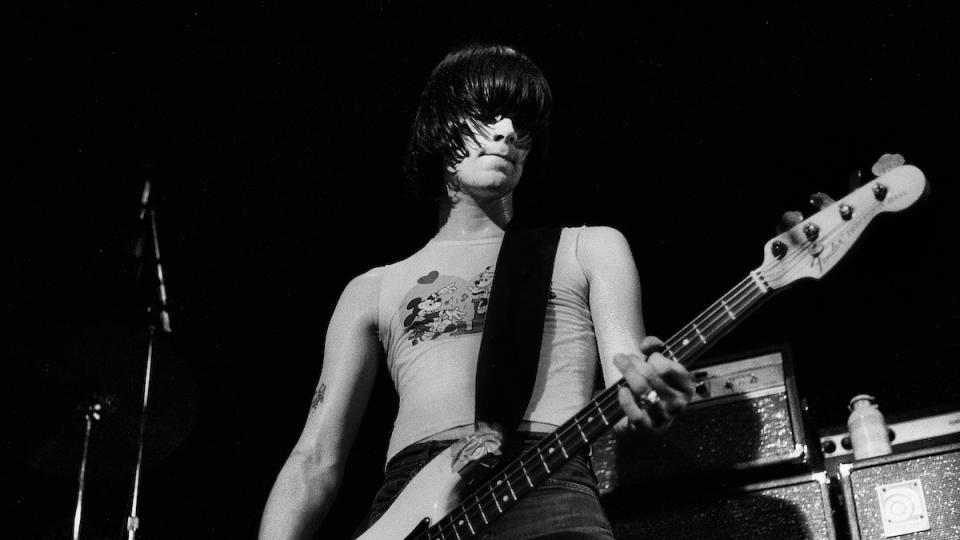
Dee Dee Ramone, photo by Paul Natkin/Getty Images
If this was a list based on technical skill alone, Dee Dee Ramone most likely wouldn’t be mentioned. But when you factor in influence and style, Dee Dee is right up there. The Ramones bassist’s rapid-fire downstrokes helped usher in punk rock, not to mention he co-wrote a number of the pioneering band’s most beloved songs. All that, plus he looked damn cool playing those tunes during the now legendary Ramones shows at CBGB. — S. Kaufman
49. Bill Wyman
In a band of great bassists (Keith Richards and Mick Taylor both laid down some grooves), Bill Wyman is in a league of his own — a chameleon for every era. He put the bop in “2120 S Michigan Ave,” the heartbeat into “Gimme Shelter,” and the swiveling hips in the disco of “Miss You.” Wyman could elevate just about any musical idea, no matter the time or tone. –– W. Graves
The rhythm section of Bill Wyman and Charlie Watts had a secret sauce that, to this day, no one has been able to recreate. — Todd Morse (The Offspring)
48. Tim Commerford
Both Rage Against the Machine and Audioslave feature the unique Tim Commerford sound of having a loud, full-bodied bass in unison with Tom Morello’s electrifying guitar. You can hear him move independently from Morello in many songs, venturing off into his own little world — but when he returns to a song’s groove, like on “Testify” or Audioslave’s “Your Time Has Come,” he is an undeniably rousing and rewarding part of each band’s sound. — P. Ragusa
47. Bobby Valentin
As much as modern dance music owes to European discotheques and the African musical diaspora, it arguably owes just as much to Salsa rhythms, and perhaps no player pushed those ideas further than Bobby Valentin. The Puerto Rican-born New York bandleader earned the nickname a nickname that translates to King of the Bass for the way he led his talented musicians from the groove. — W. Graves
A Salsa legend, they call him “El Rey del Bajo.” He’s a chosen one. — Eduardo Arenas (Chicano Batman)
46. Greg Lake
In his playing with King Crimson and Emerson, Lake & Palmer, Greg Lake was constantly in service of what those progressive, adventurous songs needed. Certainly with ELP, Lake flexed his wide-ranging abilities on the instrument, bringing imaginative basslines and unexpected flourishes to each song. A subtle virtuoso, his mastery of countermelodies made him a renowned bassist — and that’s before even mentioning his vocal abilities. — P. Ragusa
45. Kim Deal
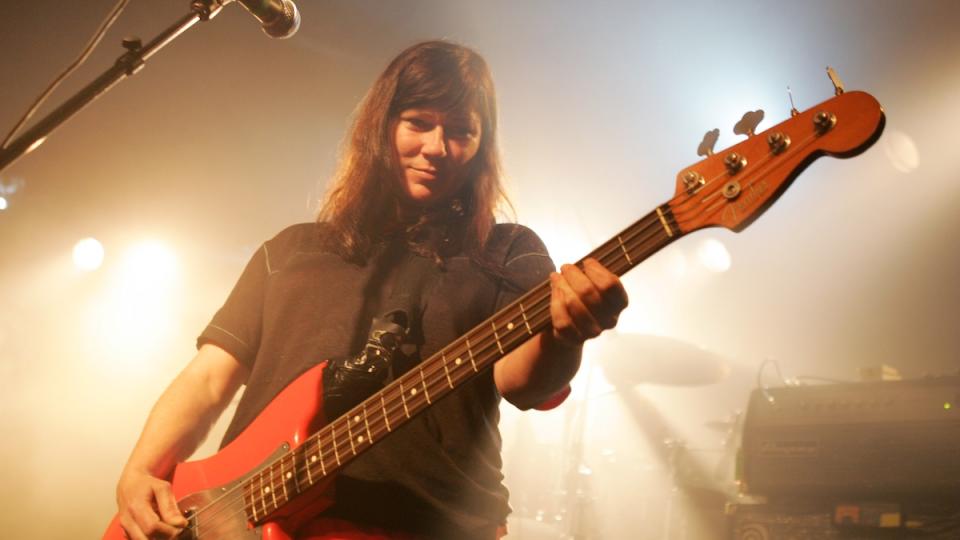
Kim Deal, photo by John Shearer/WireImage
The Pixies have this way of taking a riff and just circling different melodies around it over and over again in the most infectious way, and so many of them are Kim Deal’s basslines. But I think Deal’s whole, well, deal is why I look up to her so much, with her work in The Breeders and being a songwriter her whole life. I think approaching songs with the entirety of it in mind has a profound impact on how she plays. Plus, she just nonchalantly oozes cool and calmness when she plays. Like, who just holds a lit cigarette in their hand while playing bass and singing at the same time? — Sean Neumann (Ratboys)
44. Simon Gallup
Coming in only behind Robert Smith, Simon Gallup is the second longest-standing member of The Cure. Despite the notoriously rocky history of the band, time alone would indicate Gallup’s contributions have been an integral part of their sound. The Rock and Roll Hall of Famer’s groovy, melodic basslines are the driving force behind classic tracks like “Just Like Heaven,” “Forest,” and “Friday I’m in Love.” — S. Noor
43. Anthony Jackson
Anthony Jackson literally redesigned the bass guitar, helping create the contrabass, a six-string instrument tuned in fourths (BEADGC) rather than the standard of one octave below a guitar (EADGBE). Whether he was playing on four strings or six, and whether he was playing with jazz greats (Buddy Rich), soul icons (Chaka Khan), R&B hit-makers (The O’Jays), or legendary folk artists (Simon & Garfunkel’s The Concert in Central Park), Jackson’s prolific career speaks for itself. — B. Kaye
42. Roger Waters
Call Roger Waters any name you like and he’s probably earned it, but the reason he had a platform to annoy so many people is his bass. From the mad wizardry of “Let There Be More Light” to the irresistible groove of “Money” or the incredible atmospherics on “Atom Heart Mother,” Waters’ skill and vision supported Pink Floyd no matter where their ambitions took them. — W. Graves
41. Marcus Miller
Marcus Miller’s tone on the instrument, the way he slaps, his touch… it’s impeccable. His timing and his groove was essential. He’s one of my favorites, from his solo albums to his early work with Grover Washington Jr (specifically Winelight). He definitely opened my eyes to different styles of playing. — Blu DeTiger
40. John Myung

John Myung, photo by Sergione Infuso/Corbis via Getty Images
As a founding member of Dream Theater, John Myung is one of the definitive prog bassists. Whether he’s slapping, playing finger style or with a pick, his harmonic-heavy bass work — often bathed in a chorus effect — is always coursing through the band’s lengthy epics, weaving melodies around the similarly active guitar playing of John Petrucci. Myung’s dedication to the craft is well documented, as he has maintained a rigorous training routine over the years, once vowing to practice six hours a day, and is known to “warm down” after playing a gig. — J. Hadusek
39. John Cale
With his avant-garde background, compositional chops, and multi-instrumentalist reputation, it almost feels funny to refer to John Cale as a bassist. And, yet, that’s exactly what he was for one of the most influential rock bands of all time: The Velvet Underground. More than that, though, he was a damn good one. His bass work was just as creative and experimental as the rest of his ventures, and bands today continue to model their low-end after Cale’s even six decades on. — J. Krueger
38. Louis Johnson
Louis Johnson was a crazy, crazy funk bass player. Listening to him doing octave-driven basslines was really inspiring to me when I was learning funk music. You’re playing the root and the octave, which sounds so simple — but the way Johnson would place them, the way he’d move in between the chords, the way it’d become the driving force of the track… the feel of it is so well done. You know it’s coming from his soul and his heart, not just calculated to be on the click. — Blu DeTiger
37. Mike Mills
Mike Mills’ basslines are a master class in glue and beauty. I am constantly learning about rhythm and melody from studying his parts. — Nick Harmer (Death Cab for Cutie)
Some of the most memorable melodies on those early R.E.M. records are Mills on bass, as much as any vocal or guitar ones. Ridiculously fun to play along to. — Audrey Zee Whitesides (Speedy Ortiz)
36. John McVie
I have tried many times to play like Fleetwood Mac’s John Mcvie, or to at least incorporate his sensibilities into my playing. His playing has a warm and round feeling, yet loud and present. His work reminds me that the job of the bass player is to enhance the song and create that melodic depth without distracting from the heart of the song. A true master! — Julia Cumming (Sunflower Bean)
35. Rhonda Smith
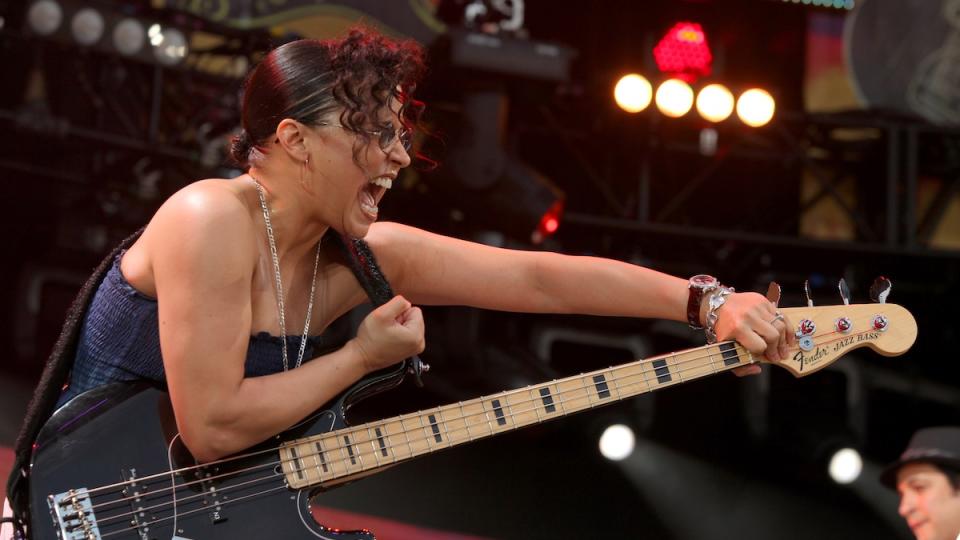
Rhonda Smith, photo by Barry Brecheisen/WireImage
Canadian bassist Rhonda Smith initially made a name for herself in various jazz fusion projects, even winning a Juno Award for with Jim Hillman’s The Merlin Factor. But her career took an iconic turn when Prince invited her to Paisley Park to record on Emancipation. She spent most of the next decade touring and recording with the Purple One, her versatility and electrifying stage presence fitting anything from The Truth to Xpectation to Crystal Ball. She joined Prince on Chaka Khan’s Come 2 My House, and was a mainstay of Jeff Beck’s band from 2010 until his passing. — S. Noor
34. Ray Brown
Known for his work with Ella Fitzgerald (whom he was married to from 1947 tot 1953) and Oscar Peterson, jazz double-bassist Ray Brown was part of Dizzy Gillespie’s rhythm section, the members of which would later form The Modern Jazz Quartet. Though Brown left before MJQ formalized, he led his own series of trios throughout the ’80s and ’90. He also appeared on tracks with the likes of Steely Dan, Lionel Richie, Arehta Franklin, Elvis Costello, and Blondie. –– V. Rittenberg
33. Billy Sheehan
In the heyday of the shred guitar style in the 1980s, Billy Sheehan was the closet thing you could get to a “shred bassist.” It’s why David Lee Roth tapped Sheehan and Steve Vai for his first solo band in an effort to create an even more outrageously talented ensemble than Van Halen. Sheehan would eventually take his talents to hard rock/AOR group Mr. Big, proving that he could also dial back the fireworks for a pocket money hit like “To Be with You.” A lifelong journeyman of the bass, Sheehan continues to lay down the low-end as a member of the The Winery Dogs. His incredible skills are perhaps best exemplified in videos of his in-concert solos from over the years. –– J. Hadusek
He was the first real rock bass virtuoso. Plus, Billy really grooves and knows how to tastefully employ his amazing chops. He does it artfully, which is important. — Jeff Pilson (Dokken/Foreigner)
32. Thundercat
Many know Thundercat from his groovy contributions to the pop and funk worlds, but seeing him live demonstrates just how imaginative and versatile he is on the bass. He’s adept at any style, switching between sticky, laid-back swirls and maniacal, psychedelic experimentation. He’s earned his place among his personal heroes of the past like Marcus Miller and Stanley Clarke. Still, Thundercat is much more interested in the future of the bass — and that’s what makes him truly great. — P. Ragusa
31. Mike Watt
Holding down the low-end for bands like Dos, fIREHOSE, late-era The Stooges, Porno for Pyros, and — of course — Minutemen, Mike Watt brought a certain jazz-funk virtuosity to punk rock. More than merely outstanding, however, Watt’s ability to marry punk and funk (pfunk, or perhaps, fpunk), as well as a plethora of other styles, laid the groundwork for countless bassists to come. Of his many disciples is none other than Flea, with Red Hot Chili Peppers even dedicating the entirety of Blood Sugar Sex Magik to the glory of Watt. — J. Krueger
Minutemen and fIREHOSE are completely driven by the basslines in my opinion. In those bands, Watt played some of the coolest, most unique basslines, all while singing. Lots of mixing of funk and jazz with a classic punk sound. –– Haylen (Hotline TNT)
30. Lemmy Kilmister
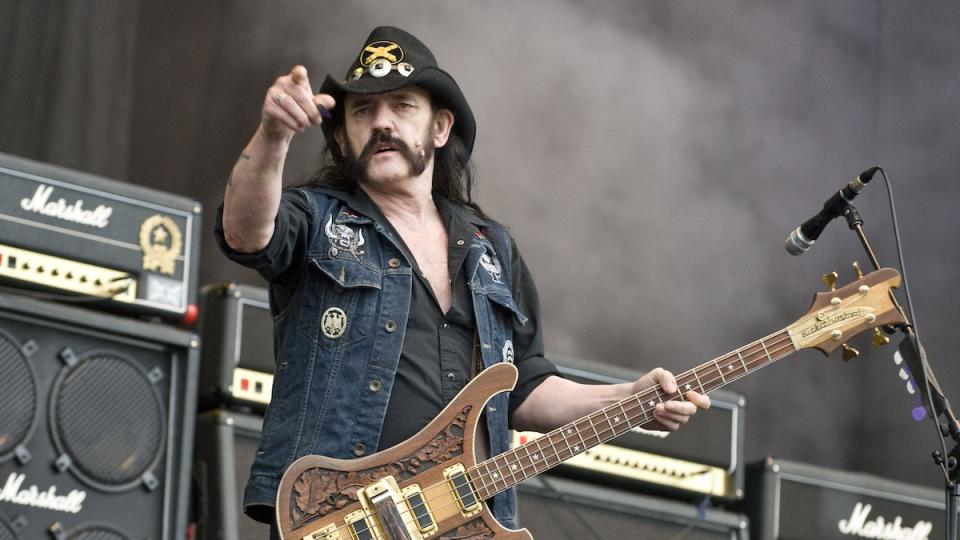
Lemmy Kilmister, photo by Steve Thorne/Redferns
Motörhead’s Lemmy is probably the biggest influence on my playing style. He played bass like a rhythm guitar, which is how I play a lot of times, especially when playing with only one guitarist. Lots of chords, lots of grit, and tons of attitude. His style was almost like a laidback bulldozer. He was the coolest. Made it seem effortless. –– Casey Orr aka Beefcake the Mighty (GWAR)
The reason why anyone puts down a guitar, picks up bass, and continues to play it like a guitar. Enough said. –– Tyler Affinito (Earthburner/Gloryhole Guillotine)
29. Ron Carter
Jazz double-bassist Ron Carter appears on well over 2,000 recording sessions, earning him the title of most-recorded jazz bassist of all time. In addition to a rich discography as band leader, he also played in the second Miles Davis Quartet (alongside Herbie Hancock, Wayne Shorter, and Tony Williams), and has credits with Chet Baker, George Benson, and Harry Connick, Jr. He even recorded with the likes of Billy Joel (“Big Man on Mulberry Street”), Paul Simon (“Run That Body Down”), and A Tribe Called Quest (“Verses from the Abstract”). — B. Kaye
28. Paul Simonon
Paul Simonon is such a melodic bass player — you can hum the basslines. A lot of those grooves that The Clash were known for, a lot of that has to do with Paul’s basslines. On top of that, he’ll always be the coolest-looking bass player of all time. — Cone McCaslin (Sum 41)
Having only switched to bass four years ago, Paul is my main inspiration. He was still learning how to play bass for The Clash only two years before he recorded London Calling! In my opinion, this is one of the most diverse rock records of all time, and Paul played every style as if he’d been doing it for decades. — Todd Morse (The Offspring)
27. Cachao
Cachao, born in Havana as Israel López, co-created the mambo with his brother Orestes by adding an improvised section to Cuban danzóns. His descargas, or jam sessions, made him a local legend, but after Castro’s communist takeover he fled in exile to the United States. He became an in-demand session musician and fixture of the New York and Miami live scenes, but it wasn’t until the 1980s and ’90s that his classic Cuban recordings received international recognition, and he was finally hailed as one of the 20th century’s masters. –– W. Graves
26. Chris Squire
Bass tone changed radically after and because of Chris Squire. His sound was jaw dropping at the time and his basslines were so fluid, melodic and exciting. He drove Yes like only such a strong bassist could. –– Jeff Pilson (Dokken, Foreigner)
A bass tone that stands out is a beautiful thing, and Chris Squire probably has the earliest example of a tone achieving near perfection for aggressive music. Doesn’t hurt that he’s no slouch with his left hand either. — Tommy Wall (Undeath)
25. Kim Gordon
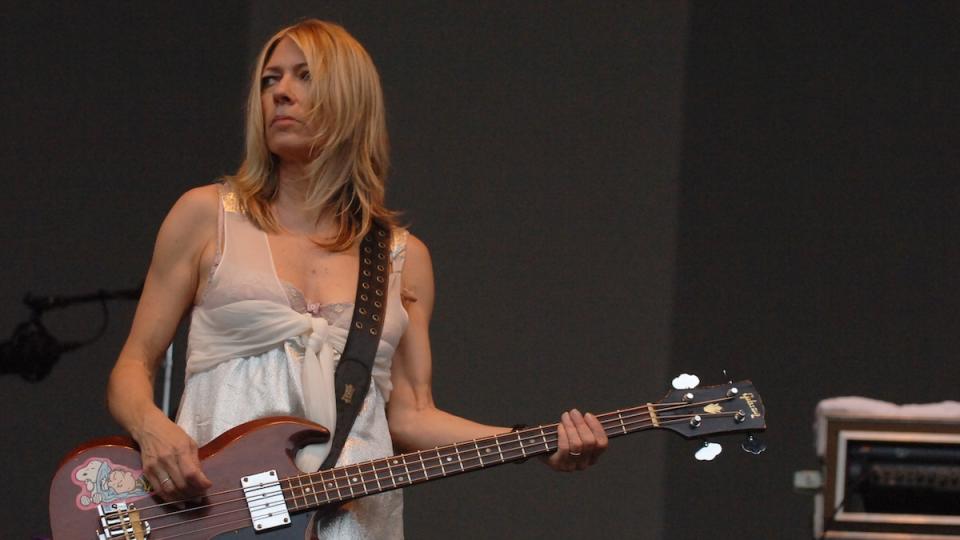
Kim Gordon, photo by Jun Sato/WireImage
Kim Gordon is many things — an accomplished experimentalist, an underground icon, a trap-rapper (!?), and an all-time great bassist. Whether she was fighting through noisy, avant-garde recordings or contributing to the chaos, the Sonic Youth member could do it all. Her radical, sensational sensibilities as both a songwriter and a performer have rightfully established her as not just one of the best bassists in rock music, but one of the genre’s most important figures. — J. Krueger
24. Donald “Duck” Dunn
As part of Booker T & the M.G.’s, the house band for Stax Records, Duck Dunn wrote so many of the bass grooves that would help define early R&B. In his Rock and Roll Hall of Fame career, Dunn cut records for Otis Redding, Bill Withers, Elvis Presley, and so many other greats. Long before most of us heard Dunn’s name — or saw him act as a member of The Blues Brothers — we loved his work. — W. Graves
23. Jack Bruce
Though Cream were only together for two years, their impact spans decades. Many will point to Eric Clapton’s legendary guitar playing or Ginger Baker’s expansive drumming, but ask any post-’60s rock bassist on this list and they’ll tell you Jack Bruce’s was just as if not more influential. His melodic agility would become the nucleus that kept the instruments around him together, even when he wasn’t in the lead, as on “Strange Brew.” — B. Kaye
22. Victor Wooten
Victor Wooten is probably the most versatile bassist I can think of. Mastered every type of technique (and made up a few along the way) all the while making it look effortless. The global bass community’s IQ has collectively been raised the past three decades he’s been teaching and playing across genres due to his efforts. — Tommy Wall (Undeath)
One of the first truly exceptional bass players I fell in love with watching and hearing, even well before I was a bass player myself. — Turanga Morgan-Edmonds (Alien Weaponry)
21. Geezer Butler
As the bassist and chief lyricist of Black Sabbath, Geezer Butler deserves credit for shaping both the sound and imagery of heavy metal as we know it. It was his nightmare vision that inspired the words of “Black Sabbath” — signaling the advent of the genre — and all across the band’s discography, his expressive playing and thick tones are paired in synchronicity with his accomplice in rhythm, drummer Bill Ward. –– J. Hadusek
Geezer is the founder of heavy metal bass. The first bassist to really put distortion on the instrument. His writing speaks for its self, creating so many of our favorite classic metal songs. — Sean Tibbets (Kamelot)
20. Larry Graham
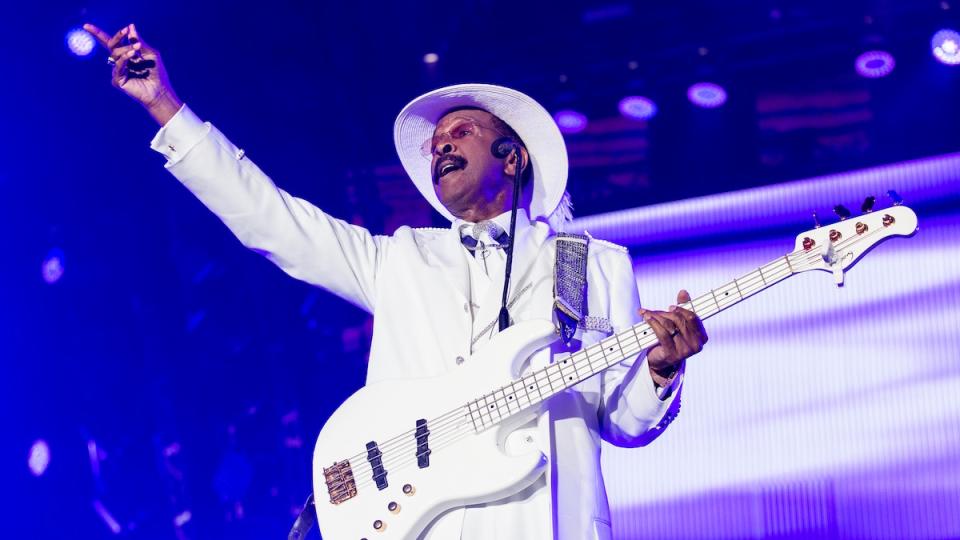
Larry Graham, photo by Josh Brasted/FilmMagic
Larry Graham brought slap bass into the mainstream through Sly and the Family Stone. He had a huge influence on how people played the instrument. He has a song on his first solo album called “Hair” that really showcases what slap bass is and how rhythmic it is, how much space it can fill and how much rhythm and harmony it can express. I practiced that for hours and hours and hours when I was learning, trying to figure out how to do those ghost notes and how to just constantly have my right hand going while the left hand was going. His bass work in Sly and the Family Stone is a little bit more simple, but his influence on music is definitely there. — Blu DeTiger
19. John Paul Jones
John Paul Jones is a master of both groove and melody. He was Led Zeppelin’s secret weapon. As well as being a great bassist, he also did all the string arrangements and keyboards for Led Zeppelin as well as writing some of their most iconic riffs (“Black Dog”). His tone on “Heartbreaker” is just plain nasty. — Justin Smolian (Dirty Honey)
John Paul Jones’ heavy Motown-infused style is Mt. Rushmore-type material for any bassist. It’s so tantalizing and impactful when he and Jimmy Page lock in together on the same riff (“Black Dog,” “Immigrant Song”). And then on songs where he ventures off on his own, he shows off how dizzyingly good he is at the instrument (“Ramble On,” the first half of “All My Love”). He set the bar higher than heaven. — Sean Neumann (Ratboys)
18. Verdine White
As a founding member of the iconic Earth, Wind & Fire, Verdine White was instrumental to the band’s success. White balances his classical training with modern, developing techniques, always keeping an eye on new things fellow bassists are experimenting with. What makes him so good is that he’s a master of his craft, through and through, and carries a deep understanding of music theory — and it shows. — M. Siroky
Verdine is the creator of some of the greatest grooves in history. — Jepha Howard (The Used)
17. Peter Hook
To play bass in just one of the most influential bands of all time is an accomplishment reserved for a select few. To play bass in two of the most influential bands of all time (related but distinct) is damn near unheard of. Yet, with Joy Division and New Order, Peter Hook did just that. It wasn’t just dumb luck either, as both acts heavily relied on Hook’s incredible low-end work. Whether it was Joy Division’s brooding tone or New Order’s club-ready new wave hits, Hook had it covered. — J. Krueger
16. Bernard Edwards
Bernard Edwards’ sense of melody, bassline composition, and feel on the bass is one of a kind. His bassline crafting is some of the best ever — he’s a huge inspiration to me. He was using the bass as a lead instrument. — Blu DeTiger
Nile Rodgers’ partner in crime gave us some of the best basslines of all time, including my personal favorites, Chic’s “Good Times” and Sister Sledge’s “He’s the Greatest Dancer,” which was later sampled on Will Smith’s ’90s smash hit “Gettin Jiggy Wit It.” — Patrick Feeley (Super American)
15. Tina Weymouth
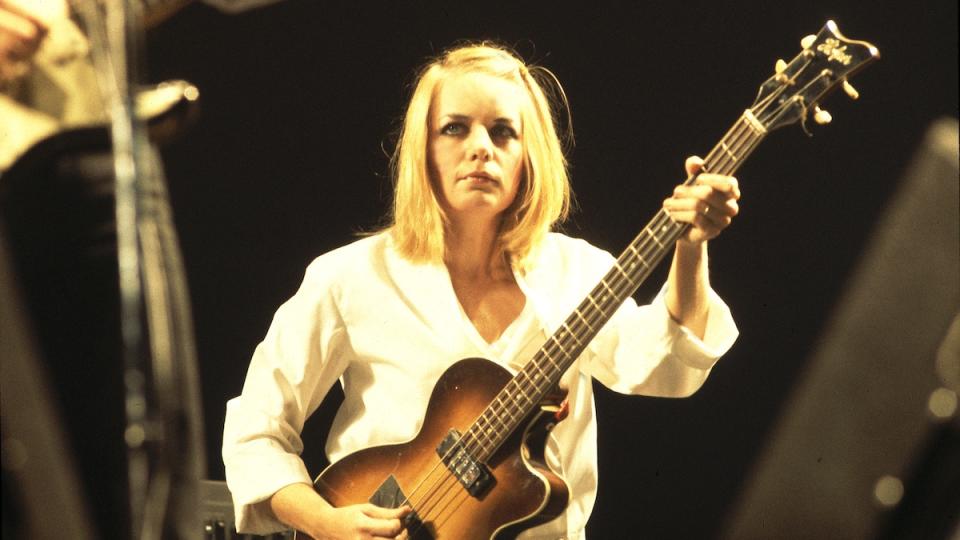
TIna Weymouth, photo by Paul Natkin/Image Direct
As the legend goes, Tina Weymouth started learning how to play the bass after joining forces with Chris Frantz and David Byrne. As a result, it’s as if Weymouth wasn’t learning the four-string outright as much as she was learning how to perfectly fit in as the bassist for the Talking Heads (and later Tom Tom Club). Her funky, artsy, intensely dancey work is now the stuff of legend, no doubt inspiring countless others to pick up the bass just as she did only a few decades ago. — J. Krueger
Tina Weymouth cannot be imitated or replicated. Besides her genius inclinations as a player, her presence in the world of rock and new wave history make her a living legend. Seeing players like her on stage created a space that can never be bought, only fought for. — Julia Cumming (Sunflower Bean)
14. Cliff Burton
Cliff Burton’s contributions to the first three Metallica LPs are immeasurable: he embodied the ethos of metal itself as the ultimate hesher bassist — humble, yet in possession of prog-level chops and an enthusiasm for sharing his ideas. It’s why he got his own instrumental on Kill ‘Em All, as well as a spotlight moment on “For Whom the Bell Tolls” — one of the most recognizable metal bass riffs of all-time. Considering how much Metallica morphed sonically and aesthetically in the years after Burton’s death, it’s safe to say that he was utterly vital to the thrash metal mastery the band captured on those early records. — J. Hadusek
Cliff Burton created a metal sound for bass playing that still resonates today. His use of fuzz/wah was unique, punchy, and creative. He made some iconic bass melodies, tones, and lines, and wasn’t afraid to take a solo. — Steve Blanco (Imperial Triumphant)
13. Aston “Family Man” Barrett
The bass player for Bob Marley’s Wailers, Aston “Family Man” Barrett passed away this past February and it made me go back listen to just how crucial his basslines were to Bob’s message. He was driving the rhythm simultaneously with a sense of melody and urgency. — Todd Morse (The Offspring)
To quote Bob Marley, “One good thing about music, when it hits you, you feel no pain.” Family Man’s basslines with Marley are classic and they just hit different! — Tobin Esperance (Papa Roach)
12. Les Claypool
Les Claypool is one of those bassist who loves bass more than most things in life. Of course, every player on this list has an incredible amount of passion, but Claypool is of the class that seemingly eats, sleeps, and breathes bass — and it shows. Not unlike what Jimi Hendrix accomplished with the guitar, Claypool approaches his craft in a unique way, producing sonics with his fretless instrument that sounds like nothing else that came before or, really, since. — J. Krueger
His approach to the bass is idiosyncratic. It’s weird and out there, but you always know it’s him playing, and it’s always awesome. Watch any live performance of Primus playing “Tommy the Cat.” — Nestor Chumak (PUP)
11. Stanley Clarke
As a member of Return to Forever with Chick Correa and as a solo artist, Stanley Clarke was a pioneer of jazz fusion. He’s also one of the most versatile bassists, playing on stage and in the studio with rock icons like Keith Richards, Jeff Beck, and Paul McCartney, among others. On top of that, his scoring credits range from Pee Wee’s Playhouse to Boyz ’N the Hood — now that’s pretty cool. –– S. Kaufman
I started on electric bass and I didn’t really get into upright until a little bit later… so those first influences were all electric players, and Stanley Clarke was definitely up there. — Trevor Dunn (Mr. Bungle)
10. John Entwistle
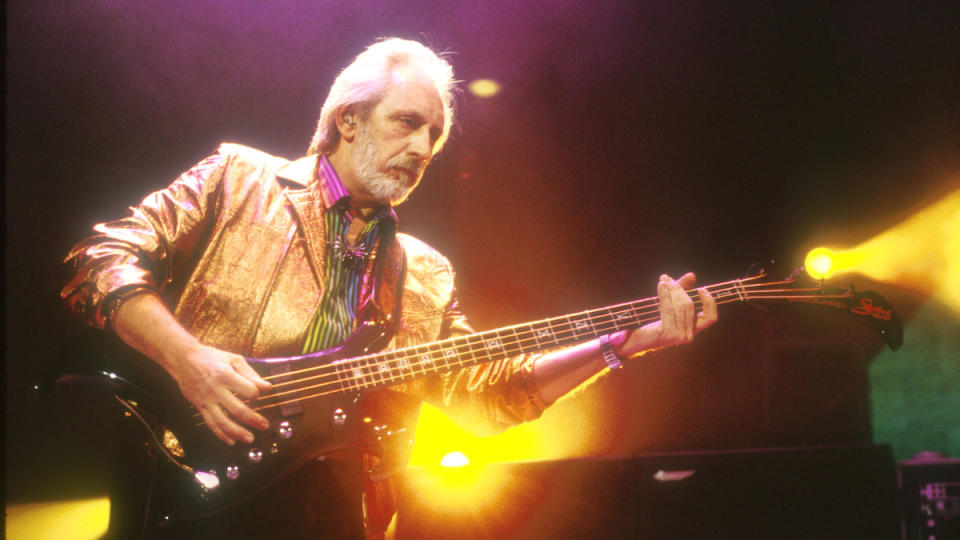
John Entwistle, photo by SGranitz/WireImage
John Entwistle’s performance of “My Generation” during The Who’s 1967 appearance on the Smothers Brothers Comedy Hour singlehandedly made me want to be a bass player. When he reaches the solo, his eyes lazily address the crowd as if he was taking a nap and not playing one of the coolest bass riffs ever written. I knew at that moment that there was nothing cooler on Earth than being a bass player. — Julia Cumming (Sunflower Bean)
09. Charles Mingus
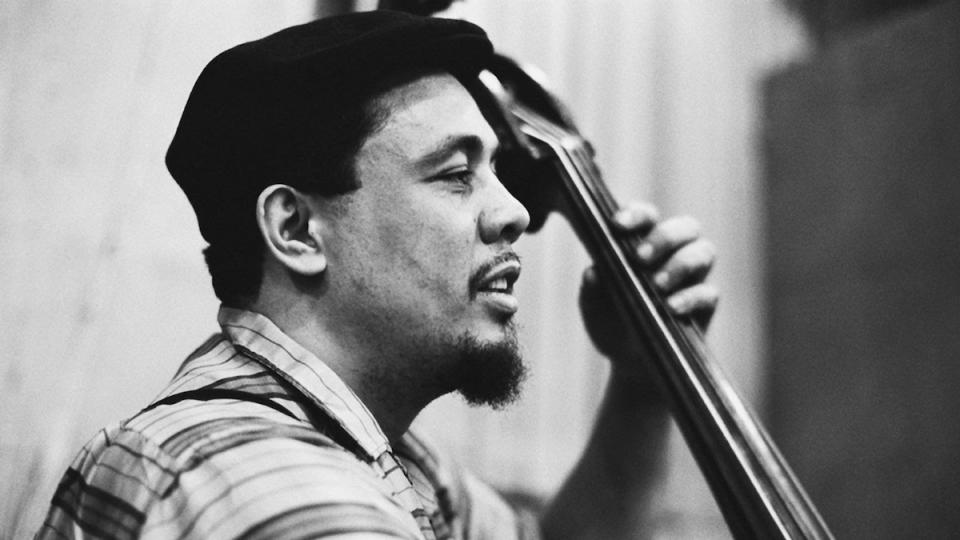
Charles Mingus, photo by Don Hunstein/Columbia Records/Getty Images
Charles Mingus is such an accomplished composer that it’s easy to gloss over his skills with the bass. A great bear of a man, he wielded his upright with tremendous physicality, and on classic basslines like “Haitian Fight Song” his strength can be felt in every booming note. His own work often pushed his bass into a supporting role, where his textured playing helped his bandmates shine. As a bassist, his masterpiece may be Money Jungle with Duke Ellington on piano, where Mingus and drummer Max Roach locked into one of the most thrilling and wild rhythm sections ever put to tape. — W. Graves
The real king. All aspects from musicianship to composition to innovation are close to peerless. — Ben Stidworthy (Cola, Ought, Brooch)
08. Steve Harris
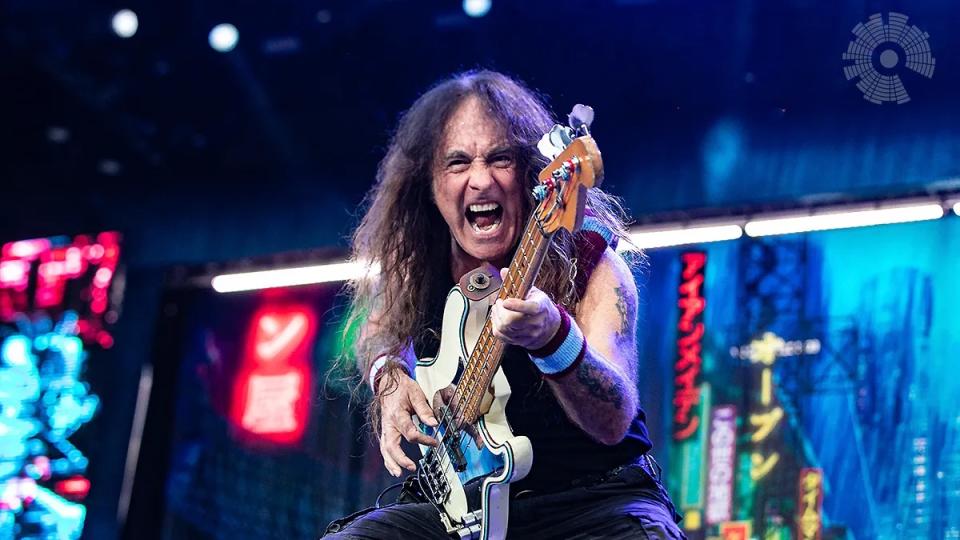
Steve Harris, photo by Raymond Ahner
When it comes to metal bass players, there’s really no better than Steve Harris. I’m not sure what the technical term is, but I call it the gallup — the 3-4 finger gallup. When you can hear five seconds of a song and you can say right away, “That’s Steve Harris,” and, “That’s Iron Maiden,” that says a lot about a bass player. The bass is mixed high in the mix rightfully so and the basslines he came up with are just metal perfection. — Cone McCaslin (Sum 41)
Steve Harris has been inspiring players for decades at this point with his playing. He is the reason why anyone interested in metal would pick learning bass over a guitar. –– Tyler Affinito (Earthburner/Gloryhole Guillotine)
07. Bootsy Collins

Bootsy Collins, photo by Jeff Hahne/Getty Images
Bootsy is just such an important player to listen to — for his sound, obviously, but also as a cultural figure, how he plays his star bass. Me being an artist whose primary instrument is the bass, I’ve always been influenced by him and how he is as an artist. Bootsy’s whole thing is the ‘one,’ the ‘one’ is key. The ‘one’ is supreme, that’s where the funk comes from… you have hit the one and then whatever you do in between is kind of up to you, as long as you hit the one. That was something that my bass teacher, when I was studying funk music, told me, he was always like, “As long as you hit the root on the one, any fill you do in between, that’s chill, you just have to make sure that you’re back for the one.” I use that all the time — no matter how many layers and how much spice you put into it, you have to keep the groove going and you have keep the bones of the song together. I think that comes from Bootsy Collins. — Blu DeTiger
06. Geddy Lee
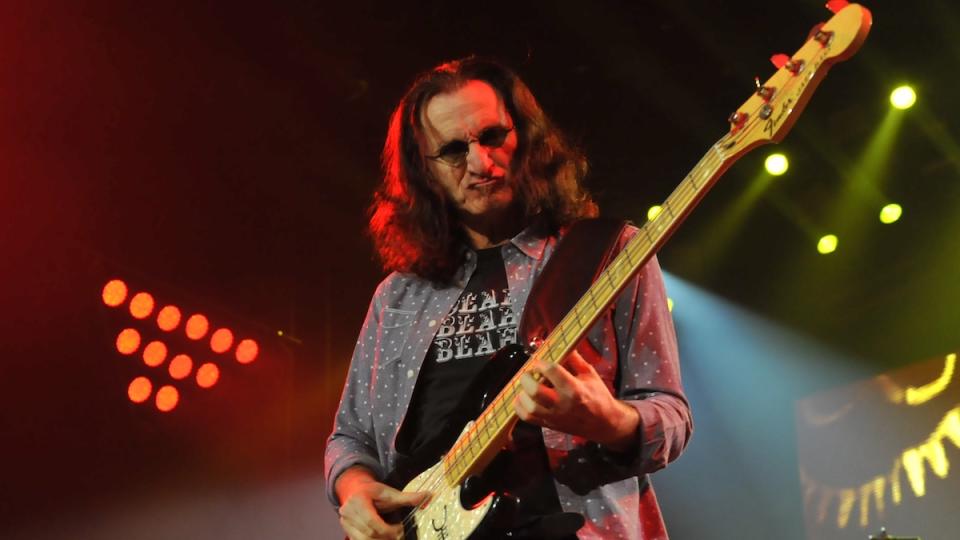
Geddy Lee, photo by Kevin Nixon/Prog Magazine/Future via Getty Images
Geddy Lee has proven to be fantastic bassist, but so much more. Playing bass, keyboards, bass pedals, even guitar on his double-neck, all while fronting RUSH as the vocalist. He writes and even tells the stories of the prolific professor Neil Peart’s mind-blowing lyrical theater, all while shredding through otherwise very heady prog-rock songs, often in 5/4 and 7/4 odd time signatures. It’s like doing math while in literary class, yet enjoying every moment of it! If there is a PhD in rock bass, it belongs to Geddy Lee. — David Ellefson (Dieth, Kings of Trash)
Geddy has an iconic tone that’s both dirty and clean. He created memorable basslines with unconventional harmonic movement, and reinvented himself through stylistic changes over the years. — Steve Blanco (Imperial Triumphant)
05. Flea
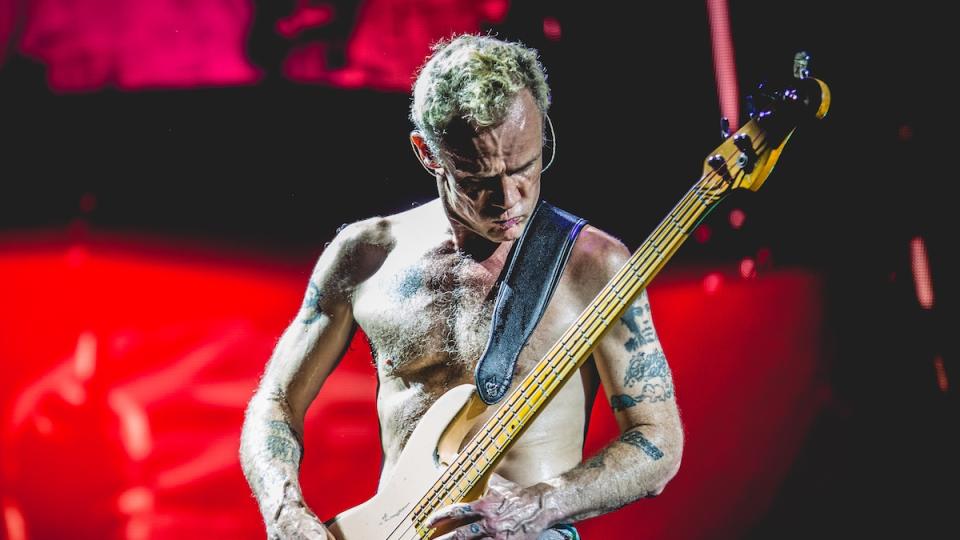
Flea, photo by Francesco Castaldo/Archivio Francesco Castaldo/Mondadori via Getty Images
Most people love Flea for his slapping style but for me it’s his finger-style playing that I really love. He has a very aggressive attack with a deep sense of groove and melody. He pushed the bass to the front of one of the biggest rock bands today as well as commanding the stage as an amazing performer. Listening to Flea as a kid opened me up to the world of funk and turned me on to all the great bass players in that genre such a Bootsy Collins, Larry Graham, Louis Johnson and so many more. — Justin Smolian (Dirty Honey)
Flea is such a staple in rock and a funk rock trailblazer. His aggressive playing and in-your-face style have been a strong influence of mine from the first time I picked up the bass. — Timmy Pee (Alien Ant Farm)
04. Carol Kaye
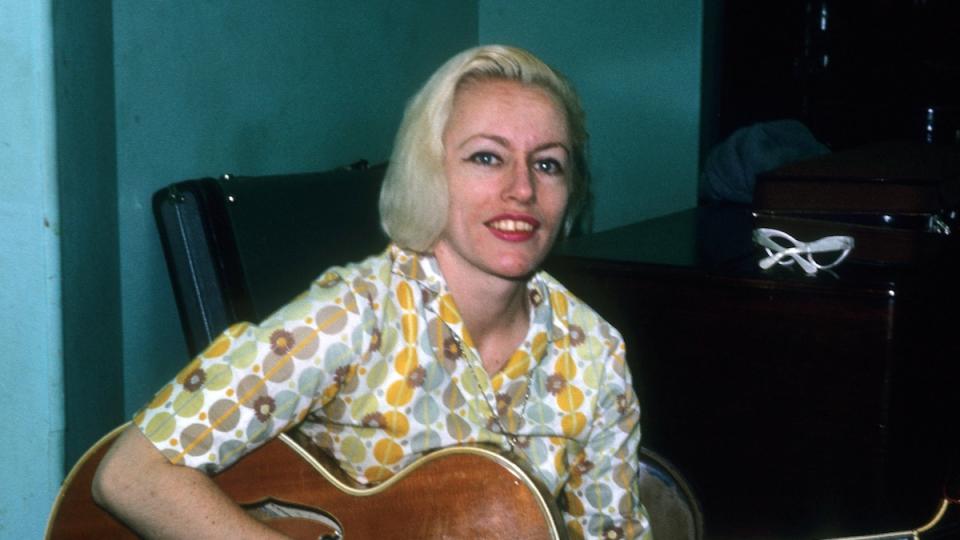
Carol Kaye, photo by Jasper Dailey/Michael Ochs Archives/Getty Images
Carol is a studio legend, forever embedded in some of the greatest recordings known to man. The strength and evenness of her playing is to die for, and the feel of her fingers and timing could bring a tear to your eye. She is an inspiration to every bass player, especially the girls like me who always dream of being inside such powerful music. — Julia Cumming (Sunflower Bean)
I don’t even know how I would think about the instrument without her emotionally evocative, harmonically dynamic lines. Every good thing everyone’s said about her should be said a thousand times more. — Audrey Zee Whitesides (Speedy Ortiz)
03. Jaco Pastorius

Jaco Pastorius, photo by Paul Natkin/Getty Images
What would be the world without a little bit of Jaco Pastorius in it? He showed us that bass isn’t just a ‘background’ instrument going in sync with the drums, but that you could really play beautiful melodies and harmonies. — Olli Matela (Blind Channel)
Jaco redefined electric bass playing and brought fretless into light. He used effects and created imaginative solos. He incorporated many styles/genres into his playing, and got an amazing warm and punchy tone throughout his short-lived career. — Steve Blanco (Imperial Triumphant)
02. Paul McCartney
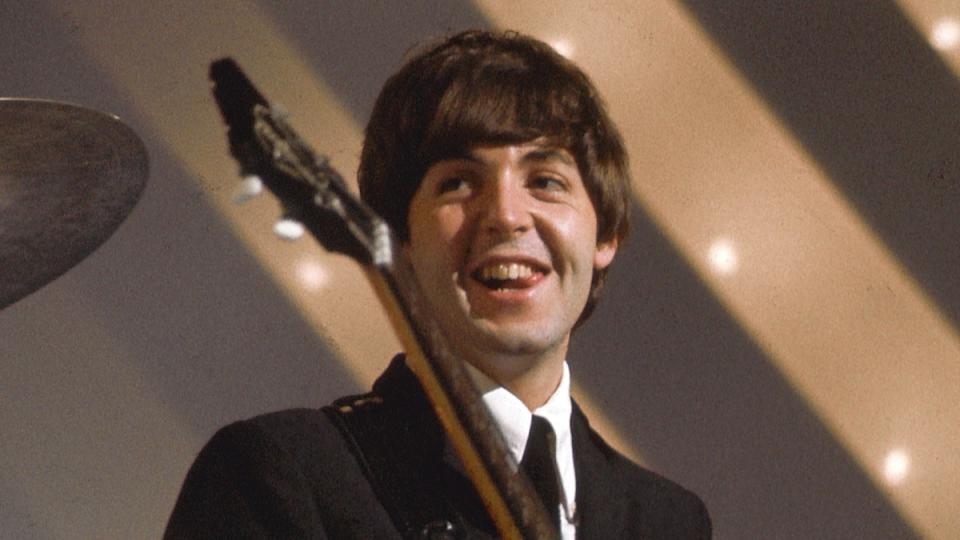
Paul McCartney, photo by David Redfern/Redferns
Paul McCartney is one of those artists who’s so good that it becomes abstract. As some have loudly pointed out, he might not be the most technically skilled bassist to ever grace pop and rock, shredding his way up and down the neck, but he didn’t have to be. McCartney’s raw talent was more concentrated; it was a sniper shot that put satisfying songwriting above all else, always crafting the perfect melodic bassline for his merry compositions. Truly, nobody has done it like Sir Paul McCartney. — J. Krueger
McCartney’s melodic lines and creativity are second to none. And he truly defines making bass parts which enhance the feel of the track and make the song so much better. He really intertwines the bass with the rhythm track so the song itself becomes deeper and more interesting. Plus he is such a huge influence on so many bassists. — Jeff Pilson (Dokken, Foreigner)
01. James Jamerson
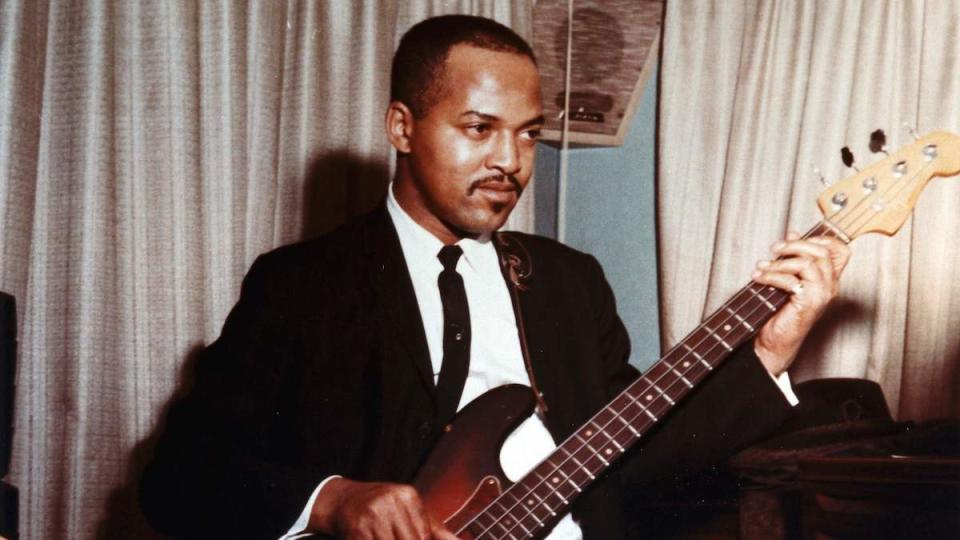
James Jamerson (Wikimedia (CC BY-SA 3.0))
James Jamerson created what would become the foundation of rock and roll and R&B bass as part of the Motown house band The Funk Brothers. His basslines created the core of most of the Motown hits and he was essential part of the Motown sound. Jamerson’s ability to create iconic basslines such as “Ain’t No Mountain High Enough” and then execute multiple permutations on those ideas without distracting the listeners while continuing to push the song forward are a masterclass in bass playing. If you do your research, you will find almost every bass player from the ’60s and ’70s list him as one of their main influences. — Justin Smolian (Dirty Honey)
James Jamerson is my No. 1 and most people’s No. 1 for a reason. When I was a little kid and first discovering and falling in love with bass, it was because of James Jamerson playing on Marvin Gaye’s album Whats Going On. My bedroom wall backed up to my mom’s stereo speakers and that sound is ingrained in my brain. — Tobin Esperance (Papa Roach)
Special thanks to all the bassists who submitted ballots to help us determine this Top 100 list:
Tyler Affinito (Earthburner, Gloryhole Guillotine)
Eduardo Arenas (Chicano Batman)
Steve Blanco (Imperial Triumphant)
Alex Bleeker (Bleeker, Real Estate)
Alexander Brown (Gatekeeper)
Nestor Chumak (PUP)
Julia Cumming (Sunflower Bean)
Blu DeTiger
David Ellefson (Dieth/Kings of Trash)
Tobin Esperance (Papa Roach)
Patrick Feeley (Super American)
Nick Harmer (Death Cab for Cutie)
Haylen (Hotline TNT)
Jepha Howard (The Used)
Noor Khan (Mamalarky)
Olli Matela (Blind Channel)
Matt Maust (Cold War Kids)
Cone McCaslin (Sum 41)
Dan Molad (Coco/Lucius)
Turanga Morgan-Edmonds (Alien Weaponry)
Todd Morse (The Offspring)
Sean Neumann (Ratboys)
Casey Orr aka Beefcake the Mighty (GWAR)
Timmy Pee (Alien Ant Farm)
Jeff Pilson (Dokken/Foreigner)
Justin Smolian (Dirty Honey)
Ben Stidworthy (Cola/Ought/Brooch)
Sean Tibbetts (Kamelot)
Nathan Vasquez (Be Your Own Pet)
Tommy Wall (Undeath)
Audrey Zee Whitesides (Speedy Ortiz)
100 Greatest Bassists of All Time
Consequence Staff
Popular Posts
Patricia Richardson Dismisses Home Improvement Reboot: "Zach is Now a Felon"
Billionaire Building Titanic II Ship With Goal of Ending Wokeness
Billie Eilish Blasts Artists Who Release Multiple Vinyl Variants to Boost Sales
Zooey Deschanel, Daughter of Six-Time Oscar Nominee, Rejects "Nepo Baby" Label
Bruce Springsteen and the E Street Band Kick Off 2024 Tour: Setlist + Video

